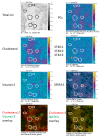Kidney Lipidomics by Mass Spectrometry Imaging: A Focus on the Glomerulus
- PMID: 30939806
- PMCID: PMC6480965
- DOI: 10.3390/ijms20071623
Kidney Lipidomics by Mass Spectrometry Imaging: A Focus on the Glomerulus
Abstract
Lipid disorders have been associated with glomerulopathies, a distinct type of renal pathologies, such as nephrotic syndrome. Global analyses targeting kidney lipids in this pathophysiologic context have been extensively performed, but most often regardless of the architectural and functional complexity of the kidney. The new developments in mass spectrometry imaging technologies have opened a promising field in localized lipidomic studies focused on this organ. In this article, we revisit the main works having employed the Matrix Assisted Laser Desorption Ionization Time of Flight (MALDI-TOF) technology, and the few reports on the use of TOF-Secondary Ion Mass Spectrometry (TOF-SIMS). We also present a first analysis of mouse kidney cortex sections by cluster TOF-SIMS. The latter represents a good option for high resolution lipid imaging when frozen unfixed histological samples are available. The advantages and drawbacks of this developing field are discussed.
Keywords: MALDI-TOF; MSI; TOF-SIMS; glomerulopathies; nephrotic syndrome.
Conflict of interest statement
The authors declare no conflicts of interest.
Figures


References
Publication types
MeSH terms
Grants and funding
LinkOut - more resources
Full Text Sources
Medical

